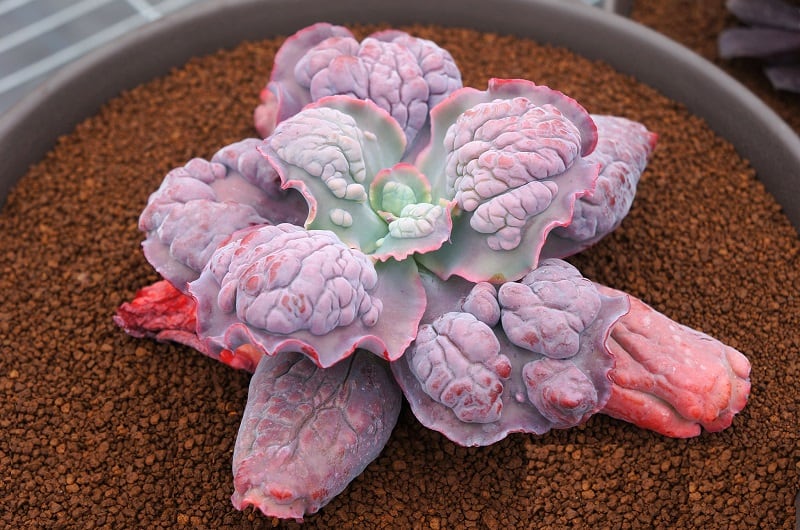Echeveria ‘Etna’, hybridized by the mother Denise, came to life in December, 1981 and was named for the volcano ‘Etna’ in Sicily.
Dick Wright, a good friend of Denise, agrees that the probable parents of ‘Etna’ are his own beautiful hybrids, Echeveria ‘Barbillion’ and Echeveria ‘Mauna Loa’.
What I love about the Echeveria “Etna” is that it folds its leaves in such a way that only the ends fold down, giving an appearance of triangular leaves.
It does this every summer, and it looks its best during autumn.
In winter, it starts unfurling its leaves, looking flat.
It will look scruffy for a while until it regains its shape back in summer.
Like typical gibbiflora-based hybrids, the Etna has huge leaves forming a large rosette.
The rosette is compact, but the stems appear to elongate fast when older leaves fall off.
This is because the leaves are large and each leaf occupies a big chunk of the stem.
Young specimens are usually smooth and start forming carunculationswithin the first couple of years.
These start off as tiny bumps in the middle of the leaf near the edges, then gradually spread out as it grows.
The carunculations form a triangular pattern that is widest halfway down.
Younger leaves have tiny edge curls while larger leaves are wavy.
But you don’t get to see these often because they fold outwards, obscuring the edges.
This odd-looking succulent may seem like its leaves are damaged, but this is typical growth for ‘Etna’.
It has large waxy, blue-purple leaves.
In the summer, the leaves fold down, making a spear-shape. In the winter, each leaf flattens out to get more sun.
You may like little jewel succulent
Tips to take care of the Echeveria “Etna”
Substratum
Porous and loose soil, it is advisable to use a special substrate for crass plants and cacti that contains river sand and small aggregates in different sizes, to ensure perfect drainage.
Transplant
If necessary, if you want to transplant the plants, you will Moderately water the plants, during spring and summer, try not to wet the leaves especially avoid wetting the center of the rosette to avoid rot, it is recommended that the water goes directly to the ground.
The amount should be moderate and the risks must be distanced waiting for the substrate to dry between them.
Pots
Use a pot of slightly larger size, we will incorporate a substrate of special quality for crass plants, if we have cut dried roots, we will wait a week before watering so that the wounds heal.
If necessary we can add a small amount of special liquid fertilizer for succulent plants, along with the irrigation water, monthly in spring and early summer.
Bright Light and Temperature
This Echeveria enjoys plenty of light.
Plant the Eheveria “Etna” in full sun or a sunny spot with some partial shade in the garden or near a south or west-facing window.
Good lighting will prevent the ‘stretching’ of the plant which encourages the redness along the edge of the plants.
The plant enjoys warm climates.
The Ideal growing temperatures are between 50 and 70 degrees Fahrenheit.
It is not a frost-hardy plant and advisable to keep the plant out of chilly winds during the colder months of the year.
It is a suitable plant for warm winter climates, does not like cold or resists frost.
As temperatures fall there is mos risk for the plant to die.
So make sure to take care of it.
Remove the dried leaves from the base of the plant to keep it healthy and the inflorescences dry.
If the weather is cold or wet it is advisable to grow the plants in pots to be able to protect during cold or rainy times.
It is advisable to use clay pots that perspire better, airing the substrate easily, so we will prevent the roots or neck of the plant from rotting.
If necessary, we will transplant the plants, we will use a pot of slightly larger size, we will incorporate a substrate of special quality for crass plants, if we have cut dried roots, we will wait a week before watering so that the wounds heal.
Propagation
It can be reproduced by seeds but it is a long process to obtain medium plants.
It can be reproduced by separating the small rosettes that grow around it, so we will get plants faster, also by leaf cutting.
The wound on the rosette or the leaf should heal before it is placed on the ground for a week.
This plant, like other fleshy plants, can be attacked by cottony cochineal in hot and humid climates, we will have to treat the plants with insecticides against cochineals for their control and elimination.
Its main enemies are intense cold, poor drainage, excessive irrigation or poor aeration.
You have to keep the plants in optimal conditions for good development.
Echeverias Pest and Diseases
This plant is fairly pest and disease free and even resistant to deer, however, it can be susceptible to mealybugs.
Especially if the dead leaves are not removed regularly.
If you find your plant has become lunch to mealybugs, get rid of them by wiping down your plant with some rubbing alcohol.
Fertilizer
As for the subscriber, although it is not a demanding plant, it will always grow, bloom more and be more beautiful if we provide nutrients.
Here the special fertilizers for cacti and succulents especially in spring, are recommended at the dose indicated by the manufacturer.
